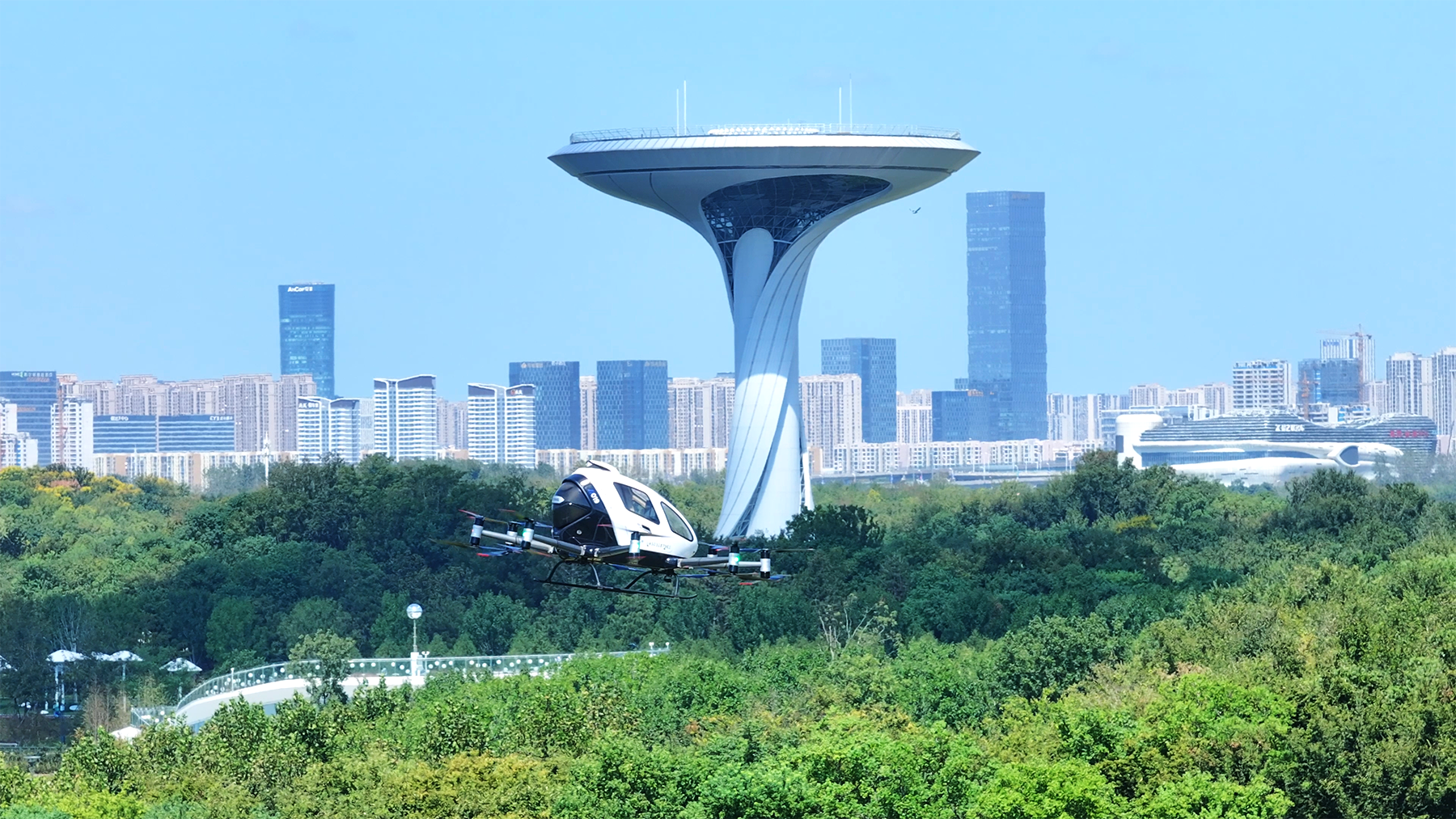Nation's newly announced, more visitor-friendly visa policy allowing curious foreigners to explore East China city

On the morning of Jan 26, just days before the Spring Festival holiday, flight KE135 touched down at Hefei Xinqiao International Airport in Hefei, East China's Anhui province.
The flight carrying 166 passengers had departed from South Korea. Among them was Elyse, a traveler from the United States, who was making her first-ever journey to China.
As she stepped off the plane and approached the immigration counter, she quickly applied for the newly introduced 240-hour temporary entry permit.
She had finished the whole process in just a few minutes and was cleared by Customs, becoming another foreign visitor to enter Hefei under the new visa-free transit policy in 2025.
READ MORE: Chinese startups giving more Western peers run for money
China announced in December a significant relaxation of its visa-free transit policy, extending the period of stay for foreign travelers from the previous 72 hours and 144 hours to 240 hours, or 10 days.
Eligible citizens from 54 countries and regions, including Russia, Brazil, the United States and Canada, can enter China visa-free. These travelers can now enter through any of the 60 ports, including Anhui's Hefei and Huangshan, across 24 provincial-level regions.
"This is my first time in China. The new policy is incredibly convenient," said Elyse.
Seizing the opportunity of a holiday break, Nazli Gul Gurlek, a student from Turkiye, was eagerly preparing for her friends' visit to Hefei.
But she wasn't just taking them to the usual tourist hotspots — she had a surprise.
"I want them to see something different, something futuristic," she said.
At the top of her list was Luogang Central Park, widely known as Luogang Park, an urban marvel that blends nature with cutting-edge technology. Built on the former site of an international airport, Luogang Park has been transformed into more than just a scenic escape.
Visitors today can hop on autonomous-driven shuttle buses to reach different attractions, hail self-driving vending machines that stop at a mere wave of the hand, and soon, they might even be able to board airborne cabs.
A major highlight within the park is an aviation transport operation center. It is expected to be a pioneering hub for low-altitude urban air mobility, potentially making Hefei the first city in the Yangtze River Delta where people can book "air taxis".
The park also serves as a testing ground for technological breakthroughs, contributing to Hefei's vision of becoming a leader in the low-altitude economy, autonomous driving and smart urban planning.
Hefei's commitment to futuristic transportation is evident in its recent agreement with EHang Holdings Ltd, a leading Chinese autonomous aerial vehicle company.
The local government has pledged support worth $100 million, including the purchase of its pilotless aerial vehicles.
This move aligns with Hefei's action plan for the development of the low-altitude economy. The plan envisions commercial routes for aerial tourism and logistics.
With an urban landscape interwoven with self-driving vehicles, eVTOL (electric vertical take-off and landing), and drone delivery services, Hefei is rapidly becoming a city where the once-imagined future is now reality.
After buying a bottle of water from an unmanned delivery service in Luogang Park, Nicolas Issac Jimenez Bravo, who now studies at Hefei University of Technology, said: "It's exciting to witness a city on the brink of something big."
For years, Hefei remained somewhat overshadowed by China's more prominent metropolises, but that perception is changing rapidly. The city is gaining traction as a hub for innovation, business and international travel.
With the extension of China's visa-free transit policy to 240 hours, Hefei is set to attract an increasing number of foreign visitors.
To support this policy, Hefei Immigration Inspection Station and the airport have implemented a series of measures to enhance passenger convenience.
Wang Chen, a police officer at the station, said a dedicated visa-free transit application area has been set up to help reduce waiting times.
Bilingual promotional videos explaining the policy and procedures were also published online. To further streamline the process, arrival cards are distributed onboard flights before landing, she said.
With the new policy, Wang said that international arrivals at Hefei's airport primarily come from Thailand, Japan, South Korea and Singapore, as well as Germany, Australia and Malaysia.
"With the 240-hour visa-free transit policy now in place, we anticipate even more foreign visitors in the near future," she added.

Beyond the airport, Hefei has been making strides to enhance its appeal to international visitors.
Hotels, for instance, have been trained to facilitate seamless checkins, bilingual signage in public spaces has been expanded, and a special immigration service counter has been established for travelers needing extended stays due to unforeseen circumstances.
In a significant digital upgrade, Hefei launched a new self-service accommodation registration system on Jan 1. Now, foreign visitors can complete their lodging registration conveniently via their mobile phones.
Hefei's airport is also expanding its reach. In the 2024 winter travel season, the airport launched direct passenger routes to Hong Kong, Macao, Osaka, Seoul, Singapore and Bangkok, broadening access to the city for global travelers.
Recognizing the needs of international travelers, the province has also focused on healthcare accessibility. The Second Hospital of Anhui Medical University inaugurated an international medical department in 2023, offering multilingual services, 24-hour emergency care, direct billing for international insurance and personalized medical assistance.
The facility had already served over 4,000 foreign patients in 2024, marking a 176 percent increase from the previous year, the hospital said.
As Hefei opens its doors wider, other cities in Anhui are also poised to benefit. Huangshan, home to China's iconic Huangshan Mountain, reported a total of 92.2 million visitors in 2024, a 10.8 percent year-on-year increase.
However, international tourist numbers remained below pre-COVID-19 levels, with only 180,000 inbound visitors in 2024 compared to 2.87 million in 2019.
The introduction of the visa-free transit policy is expected to drive a strong rebound in inbound tourism.
Such a transformation is among Anhui's broader push toward modernization and economic leadership. Traditionally overshadowed by China's coastal powerhouses, Anhui has rapidly emerged as a front runner in industries such as new energy vehicles, integrated circuits and advanced display technologies.
ALSO READ: Yangtze River Delta set to up innovation
Today, the province produces one-fifth of China's photovoltaic modules, one-seventh of its lithiumion batteries and one-eighth of its NEVs.
Lenovo, one of the world's leading tech giants, has also cemented its presence in Hefei.
"AI is not just enhancing efficiency — it's redefining what's possible in modern manufacturing," said Yang Yuanqing, chairman and CEO of Lenovo Group, in a separate interview.
Yang said Lenovo's Hefei factory now processes over 5,000 orders daily, with AI-powered scheduling slashing processing times from six hours to just 90 seconds, leading to a 23 percent increase in production efficiency.
With a seamless blend of cutting-edge technology, a welcoming environment and ambitious urban planning, Hefei is fast becoming a gateway for global travelers and a beacon of China's future-oriented development.
As Elyse wrapped up her visit, she reflected on her short stay.
"Hefei has truly amazed me. From futuristic transport to warm hospitality, I can't wait to come back and explore more."
Contact the writers at chengyu@chinadaily.com.cn


